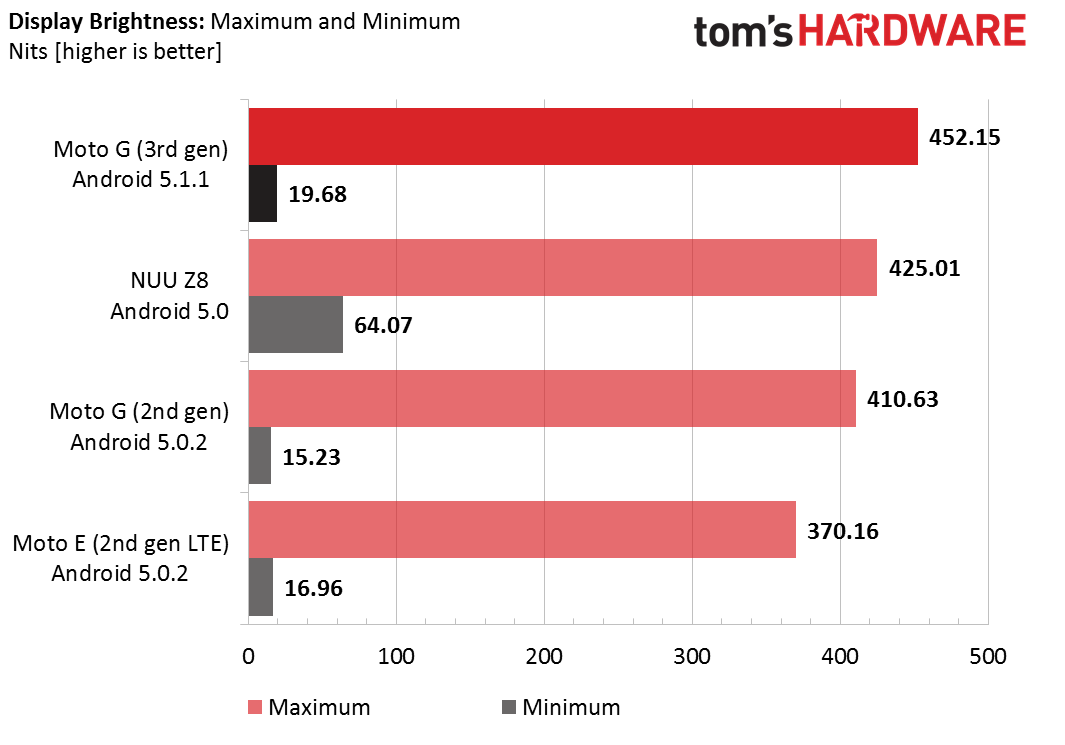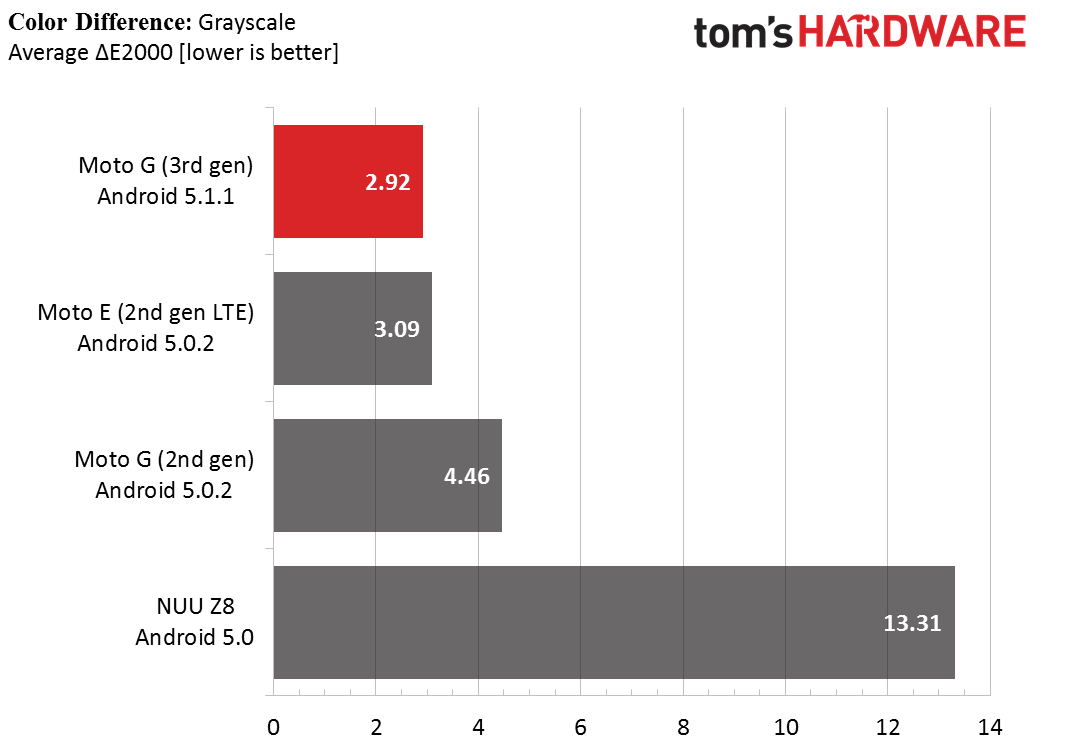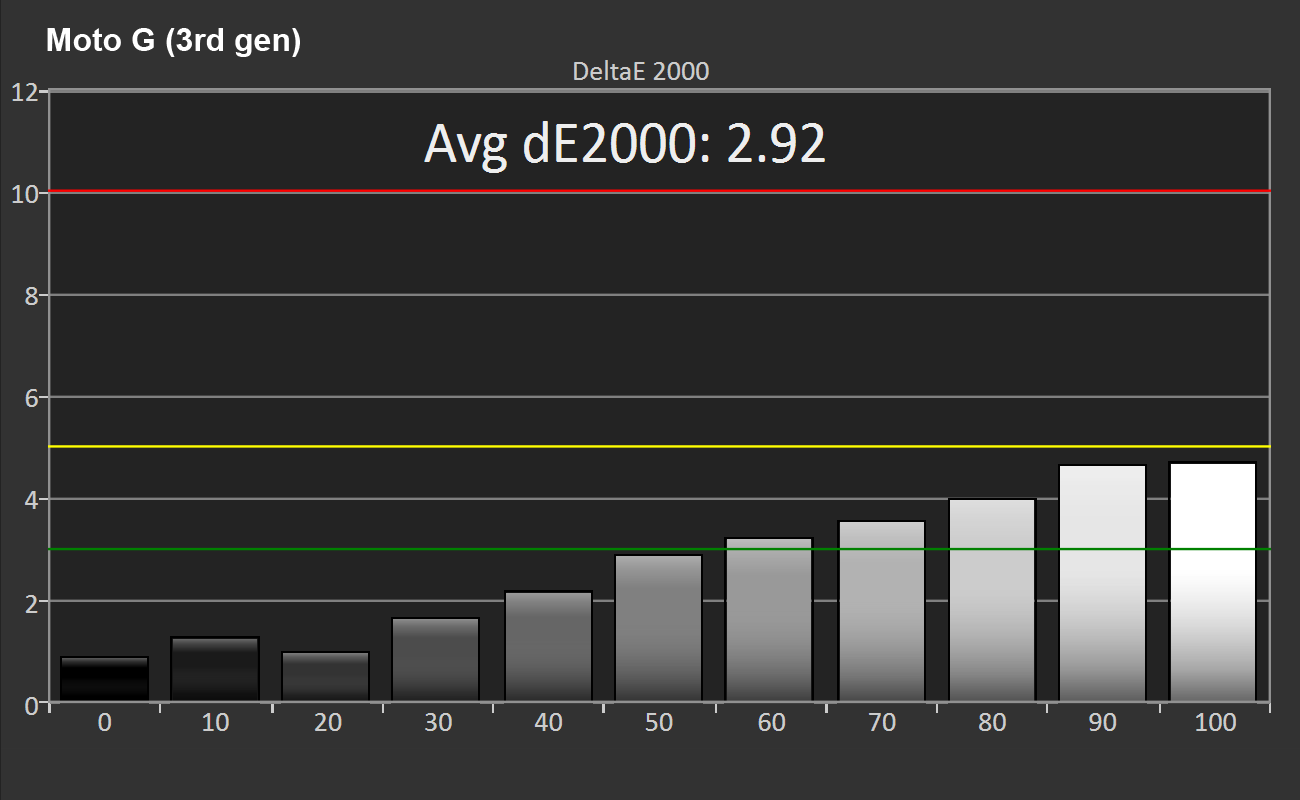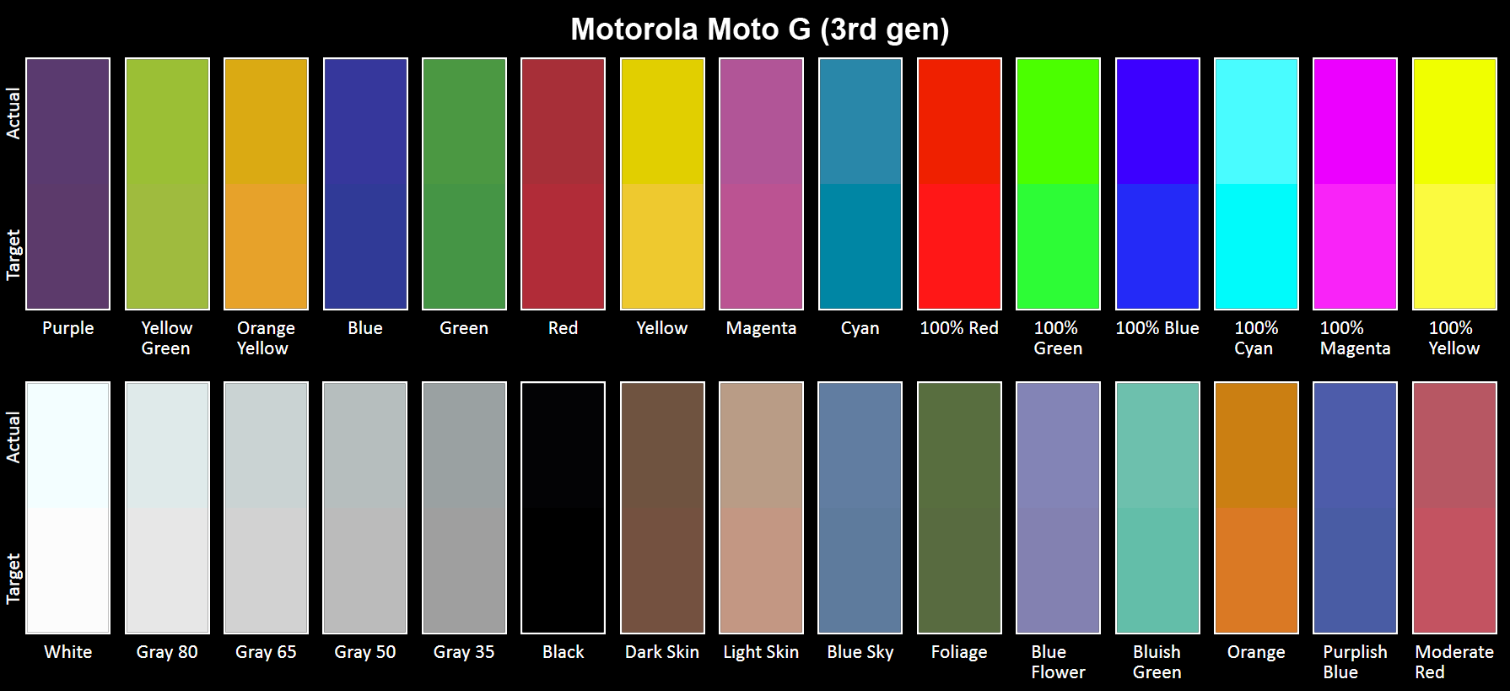Motorola Moto G (3rd gen) Review
Why you can trust Tom's Hardware
Display And Audio
The Moto G (3rd gen) comes with a 5-inch IPS display protected by Corning’s Gorilla Glass 3. Its 1280x720 HD resolution results in a 294 PPI pixel density that is common for a ~$200 smartphone. The screen is reasonably sharp, but you can see individual pixels if you look closely.
Motorola has been taking screen quality seriously on its recent phones, even calibrating the screen on its budget-priced Moto E (2nd gen). To see if Motorola gives the Moto G the same attention, we used SpectraCal's CalMAN software and SpectraCal C6 colorimeter for display measurements. All of the charts below with a gray background were generated in CalMAN v5 Ultimate.



The third-generation Moto G’s display gets pretty bright at 450 nits and is 10% brighter than the previous generation. It’s even brighter than the more expensive Asus ZenFone 2 and LG G4, making the Moto G’s screen bright enough to see in most situations.
Black level is also very good, as it is on all of Motorola’s recent displays, which leads to a respectable contrast ratio that is a slight improvement over the previous generation. At this point, we’re already seeing a trend develop: The screen on the new Moto G seems to be an improvement over the older model.


Here we see the first evidence of Motorola’s attention to detail when calibrating its displays. The average gamma of 2.18 is very close to the ideal value, and there is almost no variation over the full luminance range. With such an accurate gamma curve, the Moto G’s screen will preserve shadow and highlight detail and will help it display more accurate colors.


The display’s color temperature remains above the standard of 6,500 K, which is the color of white light outdoors on an overcast day, but is still an improvement over the previous generation Moto G that had a significantly cooler color temperature and an obvious blue tint to its display. It’s also substantially better than the Z8’s display that looks as blue as the TARDIS.
A display’s performance depends heavily on RGB balance. Since IPS displays use blue LEDs for the backlight, we always see a strong spectral emission for blue and usually significantly less for red. The Moto G’s display is no different, but we see a better balance between the three primary colors than usual. There’s a slight emphasis on blue and green and about an 8% deficit in red at 100% luminance, which is what causes the cooler color temperature. Since there’s an excess of both blue and green, we should expect a slight greenish-blue tint when viewing a white screen.
Get Tom's Hardware's best news and in-depth reviews, straight to your inbox.
With the green output so similar to blue and a smaller difference than usual between blue and red, it’s likely that Motorola is sacrificing max brightness for display accuracy by reducing the output of blue pixels.


The average grayscale ΔE2000 error falls just below three, a threshold below which error is difficult to notice. This is a very good result considering more expensive devices such as the Asus ZenFone 2 (3.85), iPhone 6 (3.97), LG G3 (4.02), and LG G4 (6.19) all show significantly more grayscale error.
In the Moto G’s case, grayscale values below 50% luminance show an error less than three and even the maximum error stays below five, which is noticeable but considered acceptable. These results tell us that a white screen will start to take on a greenish-blue tint for brightness values above 50%.


sRGB is the color space standard for mobile devices and the only color space mobile operating systems understand. The Moto G (3rd gen) does a good job adhering to the sRGB color space, although it does extend a bit too far in blue.
In the color saturation sweep, we see that there is not any color compression, shown by the fact that we have relatively equal spacing between the saturation levels of a particular color, but red is slightly undersaturated. The only significant issue here is a slight shift in the secondary colors. Magenta is shifted slightly towards blue and red and yellow are skewed towards green. This is due to the RGB imbalance discussed above, where the extra blue and green output influences the surrounding colors.


In average color accuracy, the Moto G (3rd gen) is similar to the Moto E (2nd gen), but significantly better than the previous Moto G. Most of the tested colors show an error level below three, which is the point where error starts to really be noticeable. It’s only the warmer tones (reds, oranges, yellows, browns) that exhibit larger, but still not unreasonable, error values. Looking at the color accuracy plot above, you’ll notice that all of these colors lie between red and green. The reason error is higher for these colors then relates back to the RGB balance: The higher green output combined with a deficit in red shifts all of the intermediate mixed colors towards green.
Full Size Image: [Color Palette: Moto G (3rd gen)]
The color palette above shows how the Moto G’s screen displays the tested colors on the top half compared to how the colors are supposed to look on the bottom half. As the previous tests predicted, shades of white show a small greenish-blue tint. Red appears slightly undersaturated (darker), as seen in the color saturation sweep chart, and the extra green component in the yellow, orange, and brown tones is also apparent.
Despite these issues, the new Moto G’s display is a definite upgrade over the previous model, and it will be difficult to find a brighter, more accurate display at this price point. The Moto G’s performance is better even than some flagship phones such as the HTC One M9.
Viewing angles are good with no obvious color shifting or dramatic loss in brightness, however, images do not have that “painted on” quality we’re used to seeing. Instead, the screen appears to have a grainy coating that reduces sharpness and vibrancy. We cannot tell if this is caused by the screen polarizer or an anti-reflection layer Motorola adds, but it does degrade the viewing experience.
Audio Performance
Even though it looks like it has stereo front-facing speakers, only the speaker below the screen plays audio; the smaller speaker above the screen functions solely as the phone’s earpiece. Despite this limitation, it gets just as loud as the Moto G (2nd gen).
One small issue with the external speaker is that starting around a 25% volume level, you can feel vibrations on the back of the phone, something that does not happen even at the maximum volume level on the Moto G (2nd gen).
As expected, music sounds a little tinny, but also a bit distorted, when using the external speaker, which might have something to do with the vibrations it creates inside the phone. This makes the sound less clean than on the Moto G (2nd gen). There does not seem to be any differences that are easily discernable between either Moto G when using headphones, though. The Moto G (3rd gen) sounds alright for a phone at its price point, but its performance will not impress music lovers.
The Moto G’s earpiece gets plenty loud too, sometimes to the point where you have to lower the volume because it’s almost as if you had it on speaker.
Lucian Armasu is a Contributing Writer for Tom's Hardware US. He covers software news and the issues surrounding privacy and security.




